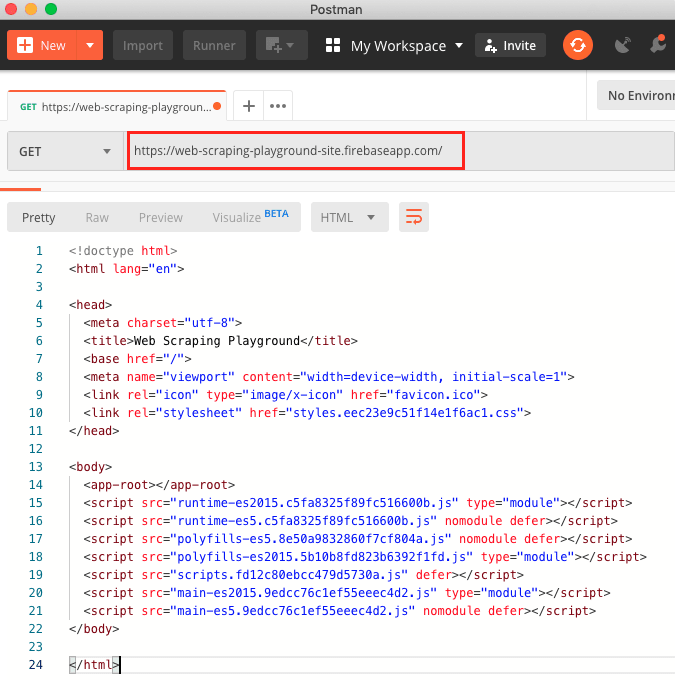In building a web scraper, we only need to know the basic structure of the web, and how to identify specific web elements. Chrome and other browser developer tools allow us to see what tags contain the information we want to scrape, as well as other attributes like “class”, that might help us select only specific elements. Link of the webapp http://mywebscraper.s3-website-us-east-1.amazonaws.com. It involves automating away the laborious task of collecting information from websites. There are a lot of use cases for web scraping: you might want to collect prices from various e-commerce sites for a price comparison site. Or perhaps you need flight times and hotel/AirBNB listings for a travel site.
React Web Scraper Software
- Python Web Scraping Tutorial

- Python Web Scraping Resources
- Selected Reading
In this chapter, let us learn how to perform web scraping on dynamic websites and the concepts involved in detail.
Introduction
Web scraping is a complex task and the complexity multiplies if the website is dynamic. According to United Nations Global Audit of Web Accessibility more than 70% of the websites are dynamic in nature and they rely on JavaScript for their functionalities.
Dynamic Website Example
Let us look at an example of a dynamic website and know about why it is difficult to scrape. Here we are going to take example of searching from a website named http://example.webscraping.com/places/default/search. But how can we say that this website is of dynamic nature? It can be judged from the output of following Python script which will try to scrape data from above mentioned webpage −
Output
The above output shows that the example scraper failed to extract information because the <div> element we are trying to find is empty.
Approaches for Scraping data from Dynamic Websites


We have seen that the scraper cannot scrape the information from a dynamic website because the data is loaded dynamically with JavaScript. In such cases, we can use the following two techniques for scraping data from dynamic JavaScript dependent websites −
- Reverse Engineering JavaScript
- Rendering JavaScript
Reverse Engineering JavaScript
The process called reverse engineering would be useful and lets us understand how data is loaded dynamically by web pages.
For doing this, we need to click the inspect element tab for a specified URL. Next, we will click NETWORK tab to find all the requests made for that web page including search.json with a path of /ajax. Instead of accessing AJAX data from browser or via NETWORK tab, we can do it with the help of following Python script too −
Example
The above script allows us to access JSON response by using Python json method. Similarly we can download the raw string response and by using python’s json.loads method, we can load it too. We are doing this with the help of following Python script. It will basically scrape all of the countries by searching the letter of the alphabet ‘a’ and then iterating the resulting pages of the JSON responses.
After running the above script, we will get the following output and the records would be saved in the file named countries.txt.
Output
Rendering JavaScript
In the previous section, we did reverse engineering on web page that how API worked and how we can use it to retrieve the results in single request. However, we can face following difficulties while doing reverse engineering −
Sometimes websites can be very difficult. For example, if the website is made with advanced browser tool such as Google Web Toolkit (GWT), then the resulting JS code would be machine-generated and difficult to understand and reverse engineer.
Some higher level frameworks like React.js can make reverse engineering difficult by abstracting already complex JavaScript logic.
The solution to the above difficulties is to use a browser rendering engine that parses HTML, applies the CSS formatting and executes JavaScript to display a web page.
React Web Scraper Download
Example
In this example, for rendering Java Script we are going to use a familiar Python module Selenium. The following Python code will render a web page with the help of Selenium −
First, we need to import webdriver from selenium as follows −
Now, provide the path of web driver which we have downloaded as per our requirement −
Now, provide the url which we want to open in that web browser now controlled by our Python script.

Now, we can use ID of the search toolbox for setting the element to select.
Next, we can use java script to set the select box content as follows −
The following line of code shows that search is ready to be clicked on the web page −
Next line of code shows that it will wait for 45 seconds for completing the AJAX request.
Now, for selecting country links, we can use the CSS selector as follows −
Now the text of each link can be extracted for creating the list of countries −

